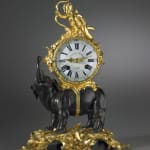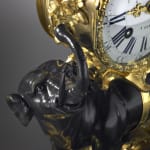Etienne Le Noir
Provenance
From a château in northern France and thence by descent.
Literature
F. J. Britten "Old clocks & Watches and their makers", 1973, p. 215, illustrating an identical clock case upon a musical box. L. Uresová "Alte Uhren", 1986, p. 110, illustrating an identical case. Hans Ottomeyer and Peter Pröschel, "Vergoldete Bronzen", 1986, p. 123, pl. 2.8.3, illustrating a comparable case by St. Germain but with elephant facing to the right, the dial surmounted by a seated putto and dial signed Moisy à Paris; and p. 124, pl. 2.8.5, illustrating a case with identical elephant and base but surmounted by a monkey and dial signed J. Baptiste Baillon, in the Residenz, Bamberg, Bavaria, with reference to another signed on the dial Fieffe de L'Observatoire housed in Schloss Fasanerie. J. Ramon Colon De Carvajal, "Catalogo De Relojes Del Patrimonio Nacional", 1987, p. 23, no. 4, illustrating a case with identical elephant and base but surmounted by a monkey, in the Spanish Royal collection. Klaus Maurice, "Fine Antique Clocks of the 17th to 19th Century", 1990, p. 66, pl. 52, illustrating a comparable elephant clock with surmounting putto, the movement by Beckaert à Paris in the Pitti Palace, Florence. G. Wannenes, "Le Più Belle Pendole Francesi - Da Luigi XIV all'Impero", 1991, p. 63 and 69, illustrating identical cases. Tardy, "Les Plus Belles Pendules Françaises", 1994, p. 192, colour pl. XXXI, showing a very similar clock surmounted by a Chinaman and dial signed Vautrin à Paris. Jean-Dominique Augarde, "Les Ouvriers du Temps", 1996, p. 90, pl. 55, illustrating a very similar case with identical elephant and base surmounted by a monkey and movement by Baillon. Elke Niehüser, "Die Französische Bronzeuhr", 1997, p. 242, pl. 893, illustrating an identical clock case. Pierre Kjellberg, "Encyclopédie de la Pendule Française du Moyen Age au XXe Siècle", 1997, p. 125, pl. C, illustrating a similar clock surmounted by a seated Chinaman, signed on the dial Gudin à Paris, and p. 126, pls. A, B and C, illustrating three other very similar cases.
An important Louis XV gilt and patinated bronze Pendule 'À L'Éléphant' of eight day duration, signed on the white enamel dial and on the movement Etienne Le Noir à Paris, housed in a magnificent case attributed to the eminent bronzier Jean-Joseph de Saint-Germain. The dial with Roman and Arabic numerals, with a fine pair of pierced gilt brass hands for the hours and minutes. The movement with silk thread suspension, verge escapement, striking on the hour and half hour on a single bell, with outside count wheel. The drum-shaped case decorated with gilt floral garlands and surmounted by an outstretched winged putto holding a bow in his right hand and arrow in the other, the clock with scrolled base supported on the back of a patinated bronze elephant with gilded girth, raised trunk and feet resting on a gilt floral and foliate rocaille plinth with C-scroll and foliate edge
Paris, date circa 1750
Height 43.5 cm, width 31 cm, depth 18 cm.
Clocks supported on the backs of exotic animals such as elephants, rhinoceroses and camels are considered among the most prized works of the mid eighteenth century, especially as only a limited number were made. As one of the most important Parisian fondeur-ciseleurs of his day, Jean-Joseph de Saint-Germain (1719-91), created a number of elephant as well as rhinoceros clocks, of which examples can be found in the Musée du Louvre, Paris and in other notable collections mentioned above. He also made other Rococo style cases such as the 'Diana the Huntress' clock, also in the Louvre and later played an important role in the Neo-classical movement. He was the son of an ébéniste Joseph de Saint-Germain (maître 1750) and Anne Legrand (d.1799), widow of the ébéniste J.-P. Mathieu. Given his family's class he would have received a sound education in addition to lessons in sculpture and draughtsmanship. At first he followed his father's profession, working for Claude-Joseph Desgodets (maître-ébéniste 1749) who specialised in making clock cases. It was probably this connection that prompted St. Germain to specialise in clock cases. Although he was active from 1742 he was not received as a maître until 1748.
The clock movement was made in the famous Le Noir workshop almost certainly by Etienne II Le Noir (1699-1778) and his son Pierre-Etienne Le Noir (b. circa 1724 - d. after 1789). The Le Noirs belonged to a great dynasty of Parisian horlogers that included nineteen clockmakers spanning five generations. Of them Etienne I Le Noir (1675-1739), his son Etienne II and in turn Pierre-Etienne enjoyed enormous repute, with production reaching its apogee during the partnership between Etienne II and his son from 1750 until the elder's retirement in 1771. When Etienne I died in 1739 he left a considerable fortune, which his children chose to renounce asserting that it would be "more of a burden than a benefit". Etienne II certainly justified this decision having amassed a personal fortune of 320,904 livres at the time of his own death. Etienne II was received as a maître in 1717 and Pierre-Etienne in 1743. Seven years later in 1750 the two formed a partnership. From their workshop at Quai des Orfèvres, they supplied clocks and watches throughout the Europe.
The courts of France, Spain, Naples, Saxony, Bavaria, Hesse-Cassel and other German principalities were among many to purchase works signed by the Le Noirs, which today can be found among the world's greatest collections. For instance, they can be admired in Paris at the Musées du Louvre, Nissim-de-Camondo and Palais du Luxembourg, as well as at Château de Versailles and the Musée des Arts Décoratifs in Lyon. Other pieces are housed at the Musées Royaux d'Art et d'Histoire in Brussels, the Museum für Kunsthandwerk at Dresden, Schloss Wilhelmsthal, Calden and the Patrimonio Nacional Spain. The HermitageMuseum in Saint Petersburg, Waddesdon Manor in Buckinghamshire, the J. Paul Getty Museum California and the MetropolitanMuseum in New York are among other great collections to own works signed Etienne Le Noir.
Etienne II and Pierre-Etienne worked in close association with various marchands-merciers including T. J. Hébert through whom the firm supplied the Garde-Meuble. Their clock cases were supplied by many of the greatest makers of the day, such as the ébénistes Charles Cressent, Bernard I and II van Risamburgh, Jean-Pierre Latz, Jacques and Adrien Dubois, Balthazar Lieutaud. In addition to Saint-Germain their bronze cases were supplied by such figures as Robert and Jean-Baptiste Osmond, the Caffiéris, Antoine Foullet, Nicolas Bonnet and Michel Poisson. Specialised parts for movements such as springs were supplied by the Richards, C. Buzot and P. Masson, while Antoine-Nicolas Martinière and Jacques Decla supplied a number of their finest dials.



